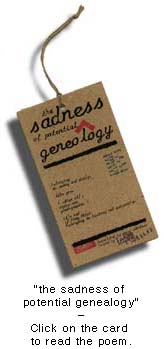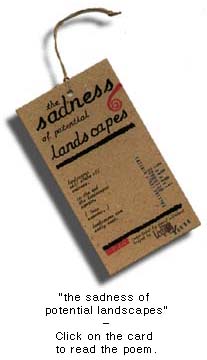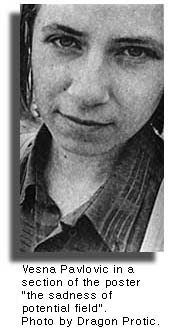| Report from Belgrade demonstrations "Awakening from the big sleep" Artists continue their work during the Belgrade protests Part 2 of "Creating Art in the Balkans" by Eloise de Leon
After weeks of watching the massive Belgrade demonstrations from my home in California, I was anxious to hear from friends, there. I combed the faces of the demonstrators through each 1-minute CNN video clip looking for familiar faces. Vesna laughed when I told of this, during our long-distance phone conversation. I had first been introduced to Vesna through her work as a cinematographer on the documentary video, Zombietown by Marc J. Hawker. There was a grace and agility in the cinematography that expressed a naturalness with the camera and maturity of the eye. "Who shot this?" I inquired of my host. "Oh, that was shot by Vesna Pavlovic, she's a member of SKART." SKART, oh great! We were scheduled to meet them in the next day or two. Gathered in the living room of the SKART headquarters one rainy day, we enjoyed a "tour" through their history of work. Three intensely creative artists comprise the group which first formed in 1990 by two young architects/graphic designers, Dragan Protic and Djordje Balmazovic. Naming themselves SKART, which means "scraps" or "discarded materials", the two worked vigorously on books/objects, using their skills in writing and design and their thirst for experimentation. Their first project was exhibited in Museé National d'Art Moderne, Centre Georges Pompidou, Paris in the international exhibition, 'The Book in All Forms'.
The mission of the group was to draw attention towards what people would otherwise not notice. SKART's work is cross-disciplinary, ranging from multi-media, literary publications, and performance, including street actions. Their work sometimes expresses personal feelings (theirs or others) which can reflect a story of the larger society. This is exemplified in "The Sadness Project" which was SKART's public declaration of personal sadness during the winter of 1992-93. Among the many works we looked at, the Sadness Project stands out in my mind as emblematic of the nature of SKART work. The Sadness project began with the publishing of one book a week. Each book is made up of 6"x3+1/4" brown cardboard pages. Each page has printing on both sides, with the front-side bearing a title and poem written by SKART's poet, Dragan Protic. On the backside there are several production notes, including a number, and "a Product of SKART" stamp. A hole was punched at the top of each page with a piece of brown twine with which to hang the page. The pages were then wrapped together with one brown paper band.
It was during that time of great depression, that the pages were distributed to strangers on the streets. Some refused and many were suspicious of someone approaching them with something free. But the surprise of each stranger was most often met with a smile upon reading the poem on the page. Vesna photographed the public reactions to the Sadness pages and published 10 of those photographs. Every week Radio B92 devoted 5 minutes of air-time to the reading of the books. Today SKART continues it's work during the Belgrade protests. Vesna laughed at my "searching for familiar faces" in the street demonstrations. "Well, you keep looking!". It was time too, to catch up with news of SKART's summer visit to Atlanta and New York during the Olympics. One of their projects had been accepted for exhibition by the Museum of Modern Art in New York. Anxious to hear about the protests, I asked Vesna to tell me something of her perspective. "Things are very exciting and we all enjoy it. I mean finally something beautiful is happening here, really beautiful, and so I'm proud to be here taking part. All these pieces are happening, like democratic precautions in people's head are starting to move. And it's going to be a big jump in our democracy, so I hope that things will continue to happen... Most of the people are for the coalition leaders, but we support democratic changes so if something happens that we have to move these people from the coalition we will move them also. The thing is to start changes, to start moving things. I think that lot's of people are going out into the streets like I do. Nearly everyday I go out, I walk or whistle or whatever I do. Lot's of people go out, not to listen to coalition leaders, but to be there and to show to the regime, and to the people and the militia and everybody that we are fighting for our rights and not for the coalition. People are awakening from the big sleep. They are making a big civilization jump, really, for a democratic society. I am surprised, it has been two months...60 days, yes. It's really a big thing and students are separately also in strike and protest for 45 days or something like that, independent from the coalition and everybody. So it's really a big thing happening and we are all waiting for some changes to happen. We are all impatient, but you know something will happen for sure."
Eloise de Leon is an artist coach, writer and filmmaker currently living in New York. Her articles may be found in the Art Changes and Human Rights / Civil Rights sections of In Motion Magazine. Her website is: www.insightandjoy.com and her email is: eloisemargaret@gmail.com. This part (2) published in In Motion Magazine, February 17 1997. |
||||||||||||
If you have any thoughts on this or would like to contribute to an ongoing discussion in the  What is New? || Affirmative Action || Art Changes || Autonomy: Chiapas - California || Community Images || Education Rights || E-mail, Opinions and Discussion || En español || Essays from Ireland || Global Eyes || Healthcare || Human Rights/Civil Rights || Piri Thomas || Photo of the Week || QA: Interviews || Region || Rural America || Search || Donate || To be notified of new articles || Survey || In Motion Magazine's Store || In Motion Magazine Staff || In Unity Book of Photos || Links Around The World NPC Productions Copyright © 1995-2020 NPC Productions as a compilation. All Rights Reserved. |
||||||||||||


 Part 1 -
Part 1 -  In 1991 SKART was joined by photographer/videographer, Vesna Pavlovic as a collaborator, and the three have continued to work together, exhibiting their work internationally. SKART members also continue their work in commercial graphic design, photography and videography.
In 1991 SKART was joined by photographer/videographer, Vesna Pavlovic as a collaborator, and the three have continued to work together, exhibiting their work internationally. SKART members also continue their work in commercial graphic design, photography and videography.
